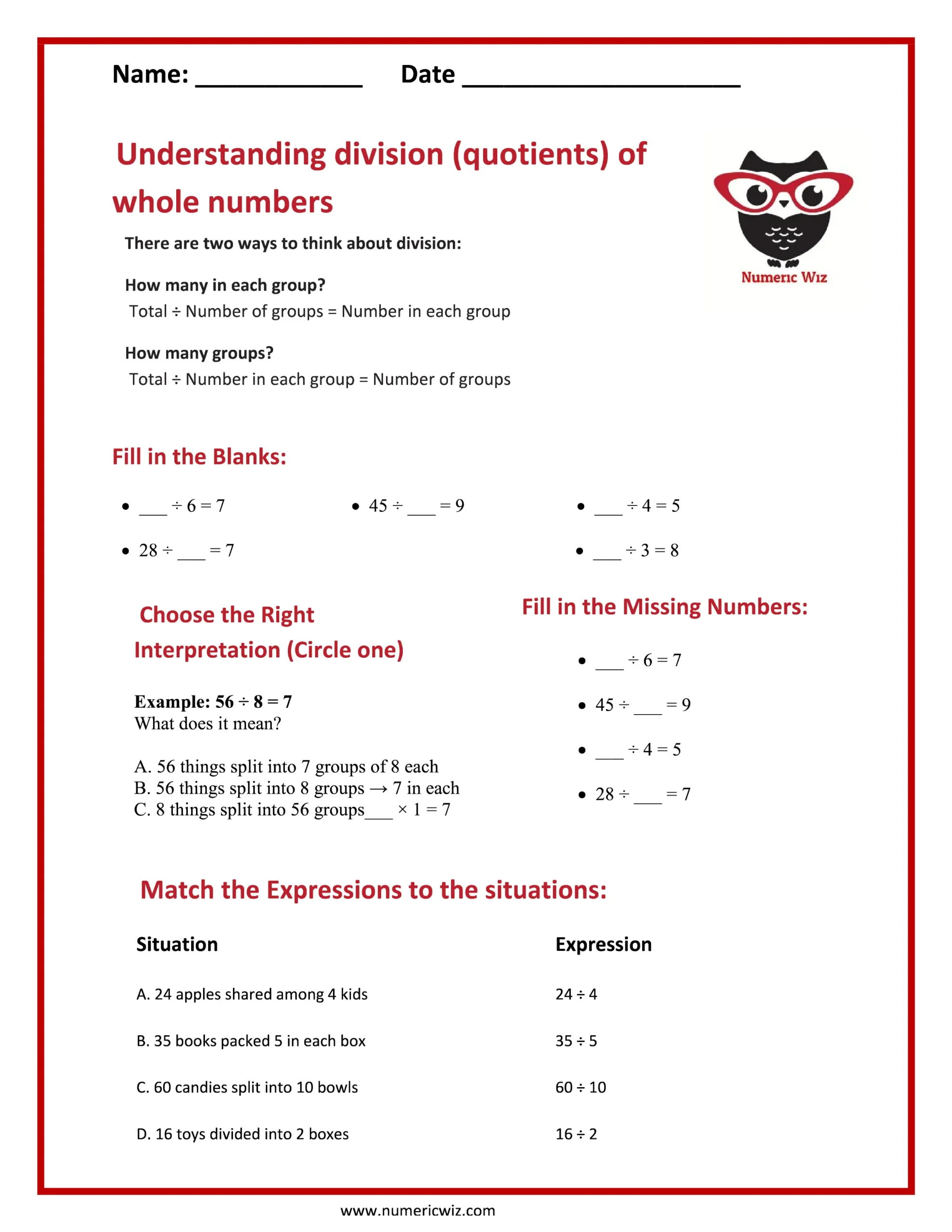The meaning behind division and what it tells us
How to find missing numbers in division sentences
How to recognize division in daily life
How to build confidence in solving and explaining division problems

This thoughtfully designed worksheet introduces Grade 3 students to the world of division the math of sharing and grouping. Whether it's splitting candies with friends or organizing toys into boxes, division helps us solve everyday problems.
Why do students often find division trickier than addition or multiplication? The reason is that division feels like “sharing” or “splitting,” which requires deeper understanding of how numbers break down. This worksheet helps students explore division step by step, so they can see it not as a difficult operation but as a logical way to find how many equal groups can be made.
Understanding Division (Quotients) of Whole Numbers means learning how to separate a number into equal groups and finding how many objects are in each group. For example, 24 ÷ 6 = 4 tells us that if 24 candies are shared among 6 friends, each gets 4 candies. Division is the foundation of fractions, ratios, and algebra, making it a vital concept for higher mathematics.

Division is the process of splitting a whole number into equal groups. The result is called the quotient, while the number being divided is the dividend, and the number we divide by is the divisor.
Example: In 35 ÷ 7 = 5, the dividend is 35, the divisor is 7, and the quotient is 5.
Historically, division methods were developed by ancient Egyptians and Babylonians, who used repeated subtraction and grouping. Today, division is applied not only in classrooms but also in daily life—sharing food, dividing money, or measuring materials.
Problem:
Ali has 36 apples. He wants to put them equally into 9 baskets. How many apples will go in each basket?
Solution:
36 ÷ 9 = 4
Each basket will contain 4 apples.
Division is more than just breaking numbers apart—it’s the key to understanding fair sharing, equal grouping, and real-world problem-solving. Without it, students struggle in fractions, ratios, percentages, and algebra. For 3rd and 4th graders, this step connects concrete ideas (like sharing candies) to abstract math symbols (like 36 ÷ 9 = 4).
Aligned with Common Core standards 3.OA.A.2 and 4.OA.A.3, this worksheet strengthens division skills through equal groups, repeated subtraction, and multiplication connections. Students not only solve direct division problems but also apply division in word problems—like dividing money, arranging teams, or splitting distances.
Step 1: Identify the numbers (dividend and divisor). Example: 42 ÷ 6
Step 2: Think: “How many 6’s fit into 42?”
Step 3: Use multiplication facts: 6 × 7 = 42
Step 4: Write the quotient: 42 ÷ 6 = 7

Example 1:
Expression: 20 ÷ 4
Meaning: Split 20 into 4 equal groups
Answer: 5
Example 2:
Expression: 56 ÷ 7
Think: “7 times what equals 56?”
7 × 8 = 56
Answer: 8
Example 3 (Word Problem):
A teacher has 45 pencils. She wants to give 5 pencils to each student. How many students can get pencils?
45 ÷ 5 = 9
Answer: 9 students
Example 4 (Real-World):
A car travels 120 kilometers in 3 hours. How many kilometers does it travel each hour?
120 ÷ 3 = 40
Answer: 40 km per hour
Sharing food equally among friends
Splitting expenses in a group trip
Dividing pages to read per day
Measuring ingredients in cooking
Calculating unit rates (speed, price per item, etc.)
Educator/Student Feedback
"Division finally made sense when I thought of it as grouping and sharing."
– Ahmad, 4th Grade Student
"My students connected division to real-life problems, and their confidence doubled."
– Ms. Fatima, Elementary Teacher
Fill-in-the-blank division facts to build fluency
Missing number problems to practice logical thinking
Interpretation questions to understand what division really means
Real-world matching of division problems to everyday situations
Each section is designed to help students learn by thinking, not just solving.

Download the worksheet, solve the practice problems, and upload your answers to our “Evaluate Your Work” page at NumericWiz.com. Our awesome teachers will check it and send personalized feedback just for you! Homework has never been this fun—or this helpful!
Discover more engaging worksheets, creative lessons, and math fun at www.NumericWiz.com
For a limited time
